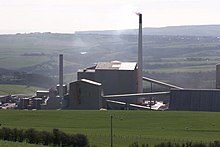Boulby Mine


Boulby Mine is a 200-hectare (490-acre) site located just south-east of the village of Boulby, on the north-east coast of the North York Moors in Redcar and Cleveland, England. It is run by Cleveland Potash Limited, which is now a subsidiary of Israel Chemicals Ltd.
At 1,400 metres (4,600 ft) deep it produces half of the UK's output of potash, an agricultural fertiliser. As a by-product the mine produces rock salt, used across the region as a de-icing agent on roads in winter conditions. The mine has 850 employees and produced more than 1m tonnes of potash in 2010.[1] It is the second deepest mine of any kind in Europe, and has a network of underground roads extending under the North Sea, totalling 1,000 kilometres (620 mi) in length.[2]
History
In 1939, potash was discovered in the area at Aislaby when drilling to look for oil. The reserves were investigated in the 1950s but appeared too deep to exploit economically. Solution mining was considered from 1962, but not pursued.[3]
Imperial Chemical Industries (ICI) began construction on the mine in 1969, and started producing potash in 1973. The mine was the source of all of the UK's home-produced potash – around 55 percent of the total UK market. It occurs between 1.2 kilometres (0.75 mi) and 1.5 kilometres (0.93 mi) below ground and has an average seam thickness of 7 metres (23 ft). It took until 1984 for the mine to achieve profitability.[4]
ICI formed Cleveland Potash Limited jointly with Anglo American, and later sold it to them, who in turn divested it to Israel Chemicals Ltd in 2002.[5]
In April 2011, the mine began the world’s first commercial production of polyhalite, a rare mineral that has been found in large quantities in a seam out to sea from the mine, total resources estimated at over a billion tonnes lying more than 1.5 kilometres offshore. The mineral has a commercial potential as an organic fertiliser.[6]
Transport
Much of the output from the mine is transported by rail, as the site is located south of Loftus along the route of the former WRMU (Whitby Redcar and Middlesbrough Union Railway), which was closed on 5 May 1958. Today the line is open from Saltburn to Boulby for goods traffic only. Teesport handles most of the bulk cargo export from the mine, via a specific potash and rock salt terminal.
Underground laboratory

Because of its depth, Boulby Mine is used to house the ZEPLIN-III dark matter detector 1,100 metres below the surface in the Boulby Underground Laboratory. It also housed the UK Dark Matter Collaboration.[7]
The mine also houses the Directional Recoil Identification From Tracks (DRIFT) detector, a low pressure negative ion time projection chamber (NITPC) designed to detect weakly interacting massive particles (WIMPs) – a prime dark matter candidate. There are currently two DRIFT detectors in operation. DRIFT-IIb, which is located 1100 m underground in the Boulby Underground Laboratory at the Boulby Mine in and DRIFT-IIc, which is located on the surface at Occidental College, Los Angeles, California, USA.[7]
Work is also being carried out at the underground laboratory by the UK Centre for Astrobiology to study extremophile organisms that can survive in a salt-rich environment.[8]
See also
- Winsford – home of Britain's largest rock salt mine
References
- ^ "Huge grant just the job at Boulby". Whitby Gazette. 15 April 2011.
- ^ Inside the potash mine one mile under the North Sea, BBC News, 24 April 2013.
- ^ Paul Sowan. "Boulby Potash Mine – a site visit". Subterranea Britannica. Retrieved 27 April 2013.
- ^ "Boulby, United Kingdom". mining-technology.com. Net Resources International. Retrieved 27 April 2013.
- ^ ICL Fertilizers. "Boulby Potash Mine, United Kingdom" (PDF). mine-explorer.co.uk. Retrieved 27 April 2013.
- ^ "A new mineral and new jobs at Boulby mine". The Guardian. 12 April 2011.
- ^ a b "Boulby Underground Laboratory". Science & Technology Facilities Council.
- ^ Rebecca Morelle (7 August 2013). "Boulby mine: Underground life gives alien clues". BBC News.
External links
- Cleveland Potash Ltd
- Discovery Channel video from How Do They Do It?
- Boulby Potash Mine NZ761183, images at UK mine exploration website
